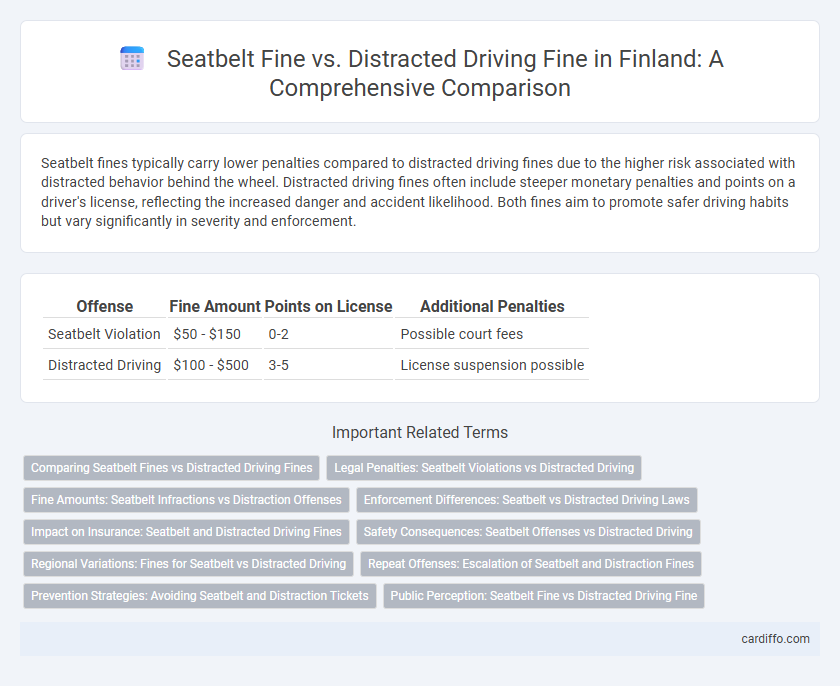Seatbelt fines typically carry lower penalties compared to distracted driving fines due to the higher risk associated with distracted behavior behind the wheel. Distracted driving fines often include steeper monetary penalties and points on a driver's license, reflecting the increased danger and accident likelihood. Both fines aim to promote safer driving habits but vary significantly in severity and enforcement.
Table of Comparison
| Offense | Fine Amount | Points on License | Additional Penalties |
|---|---|---|---|
| Seatbelt Violation | $50 - $150 | 0-2 | Possible court fees |
| Distracted Driving | $100 - $500 | 3-5 | License suspension possible |
Comparing Seatbelt Fines vs Distracted Driving Fines
Seatbelt fines typically range from $25 to $150 depending on state regulations, emphasizing the importance of compliance for basic safety. Distracted driving fines are generally higher, often reaching $200 to $500, reflecting the increased risk and potential for accidents caused by activities like texting or using a phone while driving. Comparing these penalties highlights a stronger legal deterrent against distracted driving, underlining its greater threat to road safety.
Legal Penalties: Seatbelt Violations vs Distracted Driving
Seatbelt violation fines typically range from $20 to $150, depending on the jurisdiction, and often include points on the driver's license. Distracted driving penalties are generally more severe, with fines reaching up to $500 or higher and can result in license suspension or increased insurance rates. Legal consequences for distracted driving reflect its higher risk to road safety compared to seatbelt violations.
Fine Amounts: Seatbelt Infractions vs Distraction Offenses
Seatbelt fine amounts typically range from $20 to $150, depending on the state or jurisdiction, reflecting the emphasis on basic occupant safety compliance. Distracted driving fines are generally higher, often between $100 and $500, as they address more immediate risks related to driver inattention such as texting or phone use. The increased penalties for distraction offenses aim to deter behaviors that significantly elevate the likelihood of traffic accidents compared to seatbelt violations.
Enforcement Differences: Seatbelt vs Distracted Driving Laws
Seatbelt laws typically involve primary enforcement, allowing officers to stop and ticket drivers solely for non-compliance, while distracted driving laws often require observation of unsafe driving behaviors before issuing fines. Enforcement of seatbelt violations is generally more straightforward, relying on visible non-use during routine traffic stops. In contrast, distracted driving enforcement demands proving the use of electronic devices or other distractions, making it more challenging to enforce consistently.
Impact on Insurance: Seatbelt and Distracted Driving Fines
Seatbelt fines typically result in lower increases in insurance premiums compared to distracted driving fines, as insurers view distracted driving as a higher-risk behavior linked to accidents. Distracted driving citations often lead to significant premium hikes due to the elevated likelihood of claims associated with phone use or inattentive driving. Maintaining a clean record free of both violations is crucial for minimizing insurance costs and ensuring favorable underwriting assessments.
Safety Consequences: Seatbelt Offenses vs Distracted Driving
Seatbelt offenses increase the risk of fatal injuries by up to 45% in car accidents, making compliance crucial for occupant protection. Distracted driving, including texting or phone use, significantly elevates the chance of collisions, accounting for approximately 25% of all motor vehicle crashes annually. Both violations lead to severe safety consequences, but distracted driving causes more direct impairment to reaction times and situational awareness, resulting in higher accident rates.
Regional Variations: Fines for Seatbelt vs Distracted Driving
Seatbelt fines and distracted driving fines vary significantly across regions, reflecting local traffic safety priorities and laws. In states like California, seatbelt fines start around $162, while distracted driving fines can exceed $500, emphasizing stricter penalties for phone use behind the wheel. Conversely, in Texas, seatbelt violations usually incur lower fines, near $25, but distracted driving can lead to fines up to $200, showing regional disparities in enforcement and legal consequences.
Repeat Offenses: Escalation of Seatbelt and Distraction Fines
Repeat offenses for seatbelt violations typically result in escalating fines and may include higher penalties such as court fees or mandatory safety courses. Distracted driving fines also increase substantially with subsequent violations, often incorporating points on the driver's license and potential license suspension. Enforcement agencies prioritize repeat offenders to enhance road safety, making the financial and legal consequences progressively severe.
Prevention Strategies: Avoiding Seatbelt and Distraction Tickets
Wearing a seatbelt consistently and ensuring all passengers do the same can significantly reduce the risk of receiving seatbelt fines and enhance overall vehicle safety. Minimizing distractions by using hands-free devices, setting GPS before driving, and avoiding phone use while driving helps prevent distracted driving tickets and promotes focused attention on the road. Implementing these prevention strategies aligns with traffic laws and contributes to safer driving environments.
Public Perception: Seatbelt Fine vs Distracted Driving Fine
Public perception often views seatbelt fines as less severe compared to distracted driving fines due to the immediate risk distracted driving poses to both the driver and others on the road. Distracted driving fines are perceived as critical deterrents because they address behaviors leading to higher rates of fatal accidents, such as texting or phone use while driving. Seatbelt fines, while important for safety, are generally seen as preventative measures rather than direct responses to immediate driving hazards.
Seatbelt fine vs distracted driving fine Infographic

 cardiffo.com
cardiffo.com